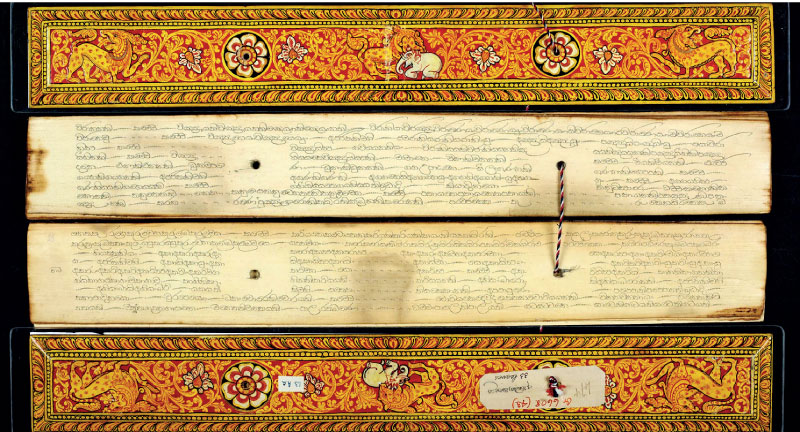Thursday Jan 08, 2026
Thursday Jan 08, 2026
Thursday, 24 June 2021 00:00 - - {{hitsCtrl.values.hits}}

The architects of the Act seem to believe that their board is capable of distilling a mythical ‘pristine and unadulterated’ version of the Theravada Tripitaka and its interpretation out of this heap of views—a feat never achieved before, either in the long history of Theravada or in decades of modern Buddhist academic studies
 Some factions of the Sri Lankan Buddhist community have been busy promoting the introduction of additional legislature to ‘protect Buddhism’ in the country. The most recent development of these efforts has been the introduction of a so-called Tripitaka Conservation Act. Cabinet approval has already been granted to a resolution by the Prime Minister Mahinda Rajapaksa, in his capacity as the Minister of Buddha Sasana, for passing this Act in Parliament.
Some factions of the Sri Lankan Buddhist community have been busy promoting the introduction of additional legislature to ‘protect Buddhism’ in the country. The most recent development of these efforts has been the introduction of a so-called Tripitaka Conservation Act. Cabinet approval has already been granted to a resolution by the Prime Minister Mahinda Rajapaksa, in his capacity as the Minister of Buddha Sasana, for passing this Act in Parliament.
Early drafts of the proposed Act have been making the rounds online, sparking lively debate among different Buddhist groups that are for and against it. This is understandable, as the Act has the potential to exert major influence on how Buddhism is practiced in the country. Therefore, its capacity to realise the lofty objectives it purports to achieve—rather than subverting them—is of critical importance.
In this article we will examine some of the fundamental problems observable in the current drafts of the Act, through a perspective informed by text-critical studies and historiography of Buddhism.
A violent protection
The proposed Act bestows the authority of defining and interpreting the Theravada Tripitaka to a board appointed by the Ministry of Buddha Sasana. Dissidents of this orthodoxy, as identified by the board, are to be prosecuted and possibly incarcerated. For repeat offenders, this can lead to a prison term of seven years and a fine of Rs. 200,000.
Proponents of the Act justify this threat of violence, which stands in stark contrast to the peaceful teachings of the Buddha, by referring to historical precedence. According to them, the Buddhist dispensation requires the support of the rulers for its preservation. To protect the sāsana, they claim, the ‘Dhamma-cakka’ (the wheel of Dhamma) is not sufficient: one requires the ‘āṇā-cakka’ (the wheel of authority) as well. The sāsana ‘purifications’ in ancient times, such as the 12th century reform movement of King Parākramabāhu of Polonnaruwa, are used as examples of how this works in actual practice.
There are several issues with this claim. Firstly, the historical records of these ancient reforms are decidedly one-sided, written by the ‘victors,’ and subject to narrative embellishments. They are valuable historical sources which require careful interpretation, not templates for deciding on modern legislation.
Secondly, those ancient reforms were events that had clear objectives and defined beginnings and ends, not exercises of perpetual policing of religious views. The proposed Act is not satisfied in simply defining what is orthodox Theravada; much of it is about continued policing (with an actual police unit, as defined in Part V of the Act) against anything that challenges this orthodoxy.
Thirdly, this appeal to historical precedence assumes that the best way to protect the Buddha’s teaching is through activities that are diametrically opposed to those very teachings. We will come back to this later in the article.
Mercurial definitions
Even if we are to take the ‘wheel of authority’ claim at face value, we still have to deal with some key assumptions in the Act which are deeply troublesome. The main three of them are:
1.There is a singular ‘Theravada’
2. There is an established and undisputed, ‘pristine and unadulterated Theravada Tripitaka’
3. There is a unanimous ‘Mahavihara tradition’
None of these claims hold up against even mild scrutiny.
1. There is no singular Theravada, and never has been: there are multiple ways of practice under that broad umbrella, within and without national boundaries. The term has no ancient history of being used to denote a singular way of practice either: not even the Pali commentaries—let alone early Buddhist texts—use it to refer to a distinct sect. Today when we use the term Theravada, we are referring to a multitude of views that coexist in harmony and in dialogue with each other.
2. The current Theravada Tripitaka comes in multiple editions, such as the Sri Lankan Buddha Jayanthi, Pali Text Society, Burmese ‘Sixth Council’ and Thai Royal. There are (admittedly minor) differences in reading between these, but more importantly, disagreements about what is considered canonical. For example, the Burmese edition considers the ‘Milinda Pañha’ (Questions of King Milinda) a canonical text, whereas the others do not.
3. The Pali commentaries, compiled during the heyday of Mahavihara in the 5th century reveal that there were many disagreements on doctrinal issues even within the great monastery. There has never been a Mahavihara tradition that did not allow a multitude of views and interpretations. The diversity of interpretation even within the different contemporary Sri Lankan Buddhist groups that support the Act exemplify this tolerance of views within what we now call the Theravada Mahavihara tradition.
The architects of the Act seem to believe that their board is capable of distilling a mythical ‘pristine and unadulterated’ version of the Theravada Tripitaka and its interpretation out of this heap of views—a feat never achieved before, either in the long history of Theravada or in decades of modern Buddhist academic studies.
Academic exceptionalism
It is in the clauses pertaining to academic studies that the Act adopts a strange classism. After describing all kinds of punishable offences in section 36.1, it declares in section 36.2–3 that ‘notwithstanding anything contained in [previous subsections], usage of the Theravada Thripitaka, Pali Atthakatha, Pali Teeka . . . solely for the purpose of academic and research purposes shall not be an offence.’ Here ‘academic and research purposes’ are defined as ‘scholarly use which is undertaken for the purposes of education and research in Buddhism at a pirivena, pirivena training institute, university or any other higher educational institution.’
Thus, a privileged, educated elite are granted special permission to play as they please with ‘unapproved’ versions of the Tripitaka and other texts. The law, it seems, is once again for the commoner only. Needless to say, as with many other things in the Act, this goes against the very teachings it purports to preserve. The Buddha declared his Dhamma to be ‘ehipassika’ (fitting to be shown), and in a ministry spanning more than four decades, he showed no preference for caste or creed.
Catch-22 of conservation
Be that as it may, and assuming that the board in charge of enacting the Act are all perfectly qualified in every conceivable way, we are still left with one nagging matter: the freedom of interpretation afforded by the Buddha’s teaching. That leads us to the following conundrum:
Nothing in the Tripitaka itself prevents one from starting a new ‘school’—regardless of whether they have followers or not—with an interpretation different from what the board will define as Mahaviharian orthodoxy. In fact, the Theravada Vinaya (monastic code) makes explicit allowance for this under the clauses pertaining to nānāsaṃvāsakatā (difference in communion).
Thus, if the board is to actually protect the Mahaviharian interpretation of the Vinaya and the Tripitaka, it has to let the new proponent continue with their new interpretation.
But if allowance is made for the new interpretation, the board is not protecting the Tripitaka in the way they intend to in the Act.
So, to protect the Tripitaka as intended by the Act, the board has to not protect the Tripitaka in actuality, and to actually protect the Tripitaka they have to not protect the Act intended for protecting the Tripitaka.
Some Catch-22, that.
(The writer is a social anthropologist whose research interests are in Early Buddhism and the anthropology of Buddhism.)